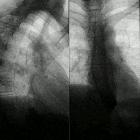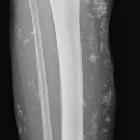Thymushyperplasie



Thymic hyperplasia is a disorder whereby there is hyperplasia of the thymus gland.
Pathology
Thymus hyperplasia can be subdivided into two forms:
Both true thymic hyperplasia and lymphoid hyperplasia manifest as diffuse symmetric enlargement of the thymus so that it is difficult to distinguish between the two types on the basis of imaging findings alone.
It is important that radiologists be able to distinguish thymic hyperplasia from neoplasm, which tends to present as a focal mass.
True thymic hyperplasia
True thymic hyperplasia associations include:
- rebound hyperplasia to chemotherapy/steroids (see: thymic rebound hyperplasia)
- radiation therapy
- burns
- other severe systemic stresses
Lymphoid hyperplasia
This is also known as lymphoid follicular thymic hyperplasia or autoimmune thymitis. Lymphoid hyperplasia associations include
Radiographic features
Diffuse symmetric enlargement of the gland is the key morphologic feature of hyperplasia (neoplasm tends to manifest as a focal mass).
MRI
Chemical shift artifact may be useful in differentiating from other tumors :
- chemical shift MRI helps differentiate thymic hyperplasia and thymus gland tumors in patients 16 years of age or older
- chemical shift MRI depicts no decrease in signal intensity of thymic tumors, unlike the decreased signal intensity of thymic hyperplasia
- this can be formally calculated using the chemical shift ratio (CSR)
Differentiating normal from hyperplastic thymus can be difficult and guidelines for making this distinction and verifying the presence of normal thymus include :
- presence of rounded soft-tissue masses 7 mm
- presence of a convex contour of the thymus beyond 19 years of age
- presence of soft-tissue lobulation
- presence of increased thymic thickness (should be ≤1.3 cm beyond age 20 years)
- presence of a diagnosis associated with thymic enlargement or hyperplasia, e.g. Graves disease
Nuclear medicine
FDG PET is often performed in patients with malignancy; however, differentiation between thymic hyperplasia and thymic involvement by malignancy is difficult because the thymus demonstrates normal physiologic uptake.
Siehe auch:
- Thymus
- Morbus Basedow
- Thymom
- systemischer Lupus Erythematodes
- Systemische Sklerodermie
- Tumoren des Thymus
und weiter:

 Assoziationen und Differentialdiagnosen zu Thymushyperplasie:
Assoziationen und Differentialdiagnosen zu Thymushyperplasie:





